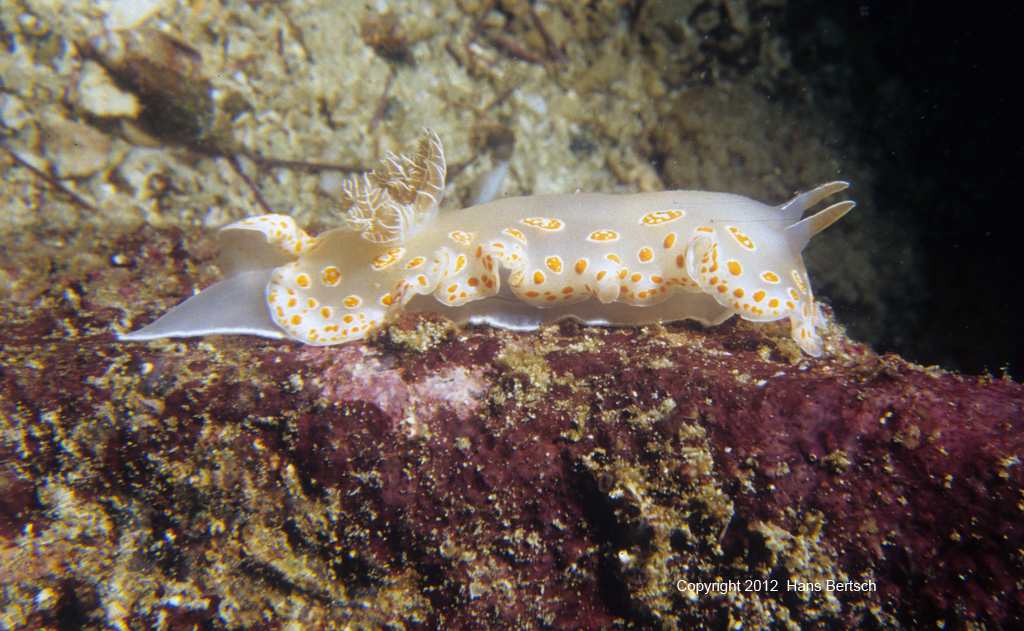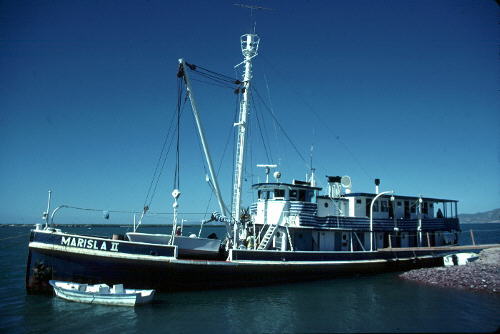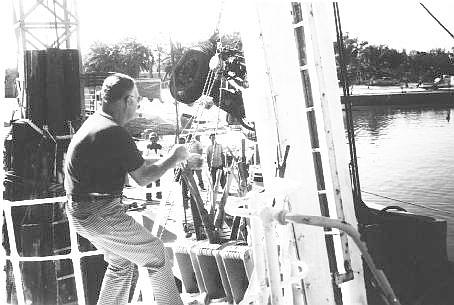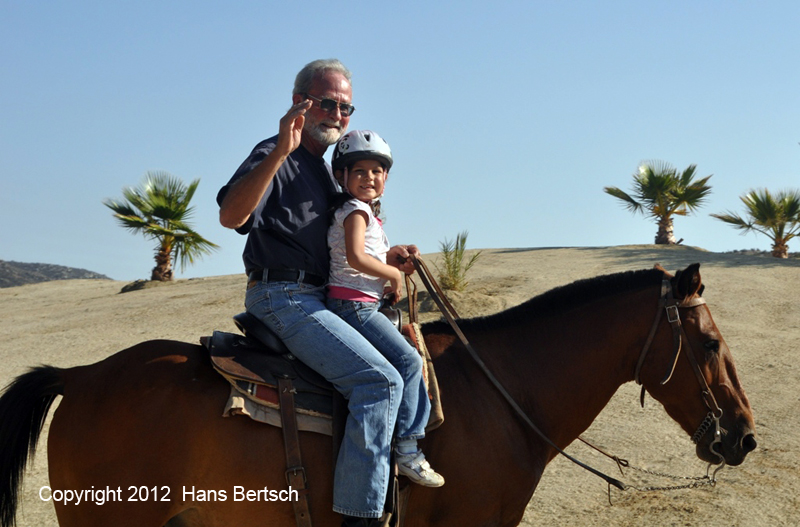 |
Chromodoris marislae
87 mm long animal, 51 foot depth
SW Isla Boni, Bahía de los Ángeles, Baja California, México
Nikonos II, f22, 1/60 second; single flash
Chromodoris marislae Bertsch, in Bertsch, Ferreira, Farmer & Hayes, 1973
This boat-named slug is a real beauty! I named the species based on specimens that Dr. Antonio J. Ferreira, Ed Janss, Dustin “Dusty” Chivers and Richard Adcock had collected while diving from the Marisla II in the southern portions of the Gulf of California. Ed’s photo of the Gang of Five shows a copulating pair and egg mass in the La Paz region.
Its northernmost occurrence seems to be at Bahía de los Ángeles , where I have observed it periodically during warmer water periods, as a member of the island community (Bertsch, et al., 1998). It is known from all three eastern Pacific tropical faunal regions (Sea of Cortez, Mexican and Panamic; see Bertsch, 2010).
Johnson and Gosliner’s (2012) recent new classification of the chromodorids list this species as an hypothesized member of the genus Felimida.
An interesting technological note about the SEMs used to illustrate the radula in the description of this species: it was the first time 3-D SEM images of a radula were published! The micrographs illustrated inner teeth of the half row , a close-up of a single innermost hamate tooth, and an elongate, denticulated tooth from the middle of the half row. To view the teeth in full three-dimensionality, look at the paired images; cross your eyes until you see three images, and then focus on the middle one. The hooks will curl out, almost tangibly, before your very eyes. (Note: This may take practice for some, but it is worth the effort.)
Less technological, but just as evocative, is Wes Farmer’s beautiful
line drawing of
Chromodoris marislae, published in our 1973 paper.
Alan Grant of Laguna Beach was kind enough to put together a short video of
Chromodoris marislae in Windows Media format
taken at Puerto Vallarta back in 2003 when Ali Hermosillo hosted the Webmaster and Alan on a Nudibranch excursion to the Nayarit-Jalisco coasts.
References
Bertsch, Hans. 2010. Biogeography of northeast Pacific opisthobranchs: comparative faunal province studies between Point Conception, California, USA, and Punta Aguja, Piura, Perú. In: Luis José Rangel Ruiz, Jaquelina Gamboa Aguilar, Stefan L. Arriaga Weiss & Wilfrido M. Contreras Sánchez (eds.). Perspectivas en Malacología Mexicana. Universidad Juárez Autónoma de Tabasco, México. pp. 219-259.
Bertsch, Hans, Antonio J. Ferreira, Wesley M. Farmer & Thomas L. Hayes. 1973. The genera Chromodoris and Felimida in tropical west America: distributional data, description of a new species, and scanning electron microscopic studies of radulae. The Veliger 15 (4): 287-294.
Bertsch, Hans, Michael D. Miller & Alan Grant. 1998. Notes on opisthobranch community structure at Bahía de los Ángeles, Baja California, México (June 1998). Opisthobranch Newsletter 24 (8): 35-36.
Johnson, Rebecca Fay & Terrence M. Gosliner. 2012. Traditional taxonomic groupings mask evolutionary history: a molecular phylogeny and new classification of the chromodorid nudibranchs. Online: PloS ONE 7 (4): e33479. doi:10.1371/journal.pone.0033479
Imperial Beach, Calif
Dec. 2012
Send Hans email at hansmarvida@sbcglobal.net

It is with profound regret that I recently learned that Richard Adcock, the skipper of the Marisla II had passed away in La Paz, Mexico, after a lengthy illness. Richard, his wife Mary Lou, and the Marisla II were an institution in the heydays of diving in the Gulf of California in the 1980's. Actually Mary Lou was the licensed skipper as Mexican Maritime law at that time would not permit a non-citizen to operate a boat in Gulf waters, but Richard was always at the helm (24/7) when the boat was out. Richard and Mary Lou had acquired the US Coast Guard buoy tender Columbine in a surplus sale after the Coast Guard retired it from Sacramento Buoy service for mechanical reasons. The Coast Guard figured changing out the main engine was not worth the trouble, so they “surplused” it. Richard purchased the vessel at a sharp discount and proceeded to just drop another engine in line with the one that wasn't working to turn the generators that ran the electric motors. Very innovative indeed. This arrangement yielded many years of useful service in the Gulf as a diving/research vessel. The most challenging phase of the transition from buoy tender to dive vessel was getting it down from San Francisco to the Gulf, no easy feat when you consider the Marisla II was a shallow draft vessel constructed for river duty. Richard was able to get the boat to La Paz, Mexico, and the rest of the story is marine biology history. Modified to serve as a live-aboard dive boat, it was renamed Marisla II. The well-known seamount to the NE of the La Paz peninsula is often referred to as the Marisla Seamount since Richard, together with one other diver, was the first to dive that seamount (now known for the large number of hammerhead sharks frequenting the seamount). |
The one liability of the boat in Mexican waters was its shallow draft, which created an instability during storms. For that reason, Richard always sought out protected areas during the night and was very careful during the day. I can recall Richard being up at night, every other hour on the hour, to check the anchor and what not.
In 1988, anticipating a time when they would retire from the business of running dive trips, Richard and Mary Lou opened the Aquamarina RV Park in La Paz, located on property they had acquired over many years. The RV park became very popular and, as commented on by many RV'ers, was the best RV park in Baja California. Following the sale of some of their property, Richard and Mary Lou closed the RV park in 2005 and truly retired.
Shortly after I got certified in 1977, I immediately began looking for dive locations to practice underwater photography with my Nikonos III and single strobe. Through luck I made the acquaintance of Jerry Allen who evolved to become a lifetime dive partner. At that time Jerry and his lovely wife Lesley were running trips out of La Paz on Richard and Mary Lou Adcock's Marisla II.
There are many "Richard" stories, but the one I remember best was the time a group of us were on the deck taking our gear off and complaining about the dearth of nudibranch sightings. Richard patiently listened to our grumblings and geared up to "deflate" our lack-of-sightings balloon. Gearing up for Richard only meant putting on a tank, regulator and fins. He reappeared 15 minutes later with a jar full of sea slugs and asked us what the problem was. Typical Richard, but in passing it should be noted that Richard went down to about 150 ft. to make the collection, a depth I would never go to under any circumstance. Well, Richard excelled in deep diving.
Richard describes the end of the era of the Marisla II circa 2001:
"...I guess I always thought that Marisla was invincible. Getting close into the dive areas was always my motto. So it was that fateful night of June 2 and the dawn of June 3rd. The anchor was foolproof when properly deployed. The wind was howling, almost normal for the Chromwell wind of Summer. But a gust spun the ship around broadside to the wind and began dragging towards shore. Alarms told us of the news, and the engines were on before we touched that solitary large rock. The pounding commenced and continued for the next five hours. We were committed to the beach, what with the now dropping tide. Sea water poured in through a gaping hole into the cargo (compressor) room area. The pumps seemed to be handling the job, but the sea won the battle.
“Dr. Wright Cortner, our dear friend, and his family were off loaded onto our skiffs and taken to the next bay south, which was Pichilingue Harbor. We arranged for three taxis to haul the 14 along with all luggage to the Hotel Los Arcos. Then we dispatched the crew. Remaining were just to the two of us, crying our hearts out. The ship took a 14 degree list which allowed the sea water to pour into the engine room snuffing out our running light plant. Main engines had already been turned off.
“The Mexican Navy took over the salvage at 8 am, finished getting the ship off the rock three days later and towed her to her place on our dock.
“All arrangements are being made to tow her once again to Loreto for a decent memorial service and sinking in a likely place for the creation of the Marisla Reef. The mast will be allowed to rise above the surface where a night light will be placed and a bronze plaque. In Loreto, the hotels will be supplied with a well-done folder describing Marisla and her history. Letters from all who knew her will be included..."
Fred Metcalf, on his Baja California Travelers Message Board wrote, "...I too am looking forward to visiting the Marisla in her final resting place at Loreto. Many fond memories of past trips are sure to be revisited while exploring the Marisla in her new role as an underwater reef. What more can be said, an ode to one of the best dive boats and skippers that ever sailed the Gulf of California!..."
Postscript(12/17/2012):
Alas, fate has intervened in plans to revisit the final resting place of the Marisla II as that place has turned out to be the scrap yard as described in a note received from
Fred Metcalf last night!
"...It was certainly Richard's wish that the Marisla II be dropped to the
bottom off Loreto, and all others seemed in agreement. However, Mexican
bureaucracy got in the way and, after a delay of almost two years, the
difficult decision had to be made to remove the ship before it became a
hazard to other vessels in the La Paz anchorage. Without government
permission to tow the ship to Loreto, the only option was to dismantle
the ship in place. That took place over many months, and so the Marisla
II went to the scrap yard rather than serve as a diving mecca in the
Loreto Marine reserve. A sad process which Richard had to partially
supervise.
My wife and I just returned from several weeks in La Paz where we
continue to keep a trailer on the Adcock property. Mary Lou is
beginning to make the difficult adjustment to a life without Richard,
but one which now includes Richard's youngest son, Roger, and his wife.
They will be living on a permanent basis on the Adcock property and
helping to reopen the RV park..."
Send Fred email at ftm@math.ucr.edu
Richard Adcock at the controls of Marisla II during the operation to
remove fuel trucks from the wreck of the Salvatierra, circa 1976.
Photo courtesy of Fred Metcalf
 |
The mold that created Richard Adcock is gone forever, there will never be another like Richard in my lifetime, that is for sure! In closing, I would like to acknowledge the following sources, without which this commerative BOW would have never been possible:
The Wreck of the Salvatierra , posted by Fred Metcalf posted on the Baja California Travelers Message Board.
|
 |
